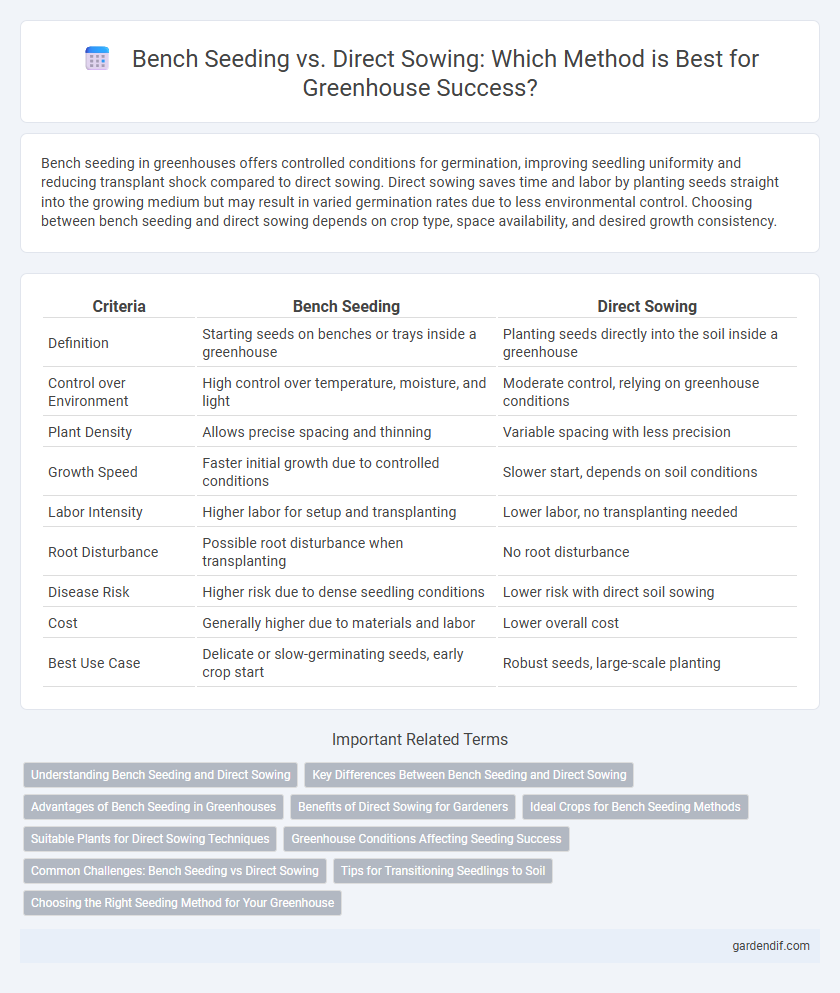
Bench Seeding vs Direct Sowing Illustration
Bench seeding in greenhouses offers controlled conditions for germination, improving seedling uniformity and reducing transplant shock compared to direct sowing. Direct sowing saves time and labor by planting seeds straight into the growing medium but may result in varied germination rates due to less environmental control. Choosing between bench seeding and direct sowing depends on crop type, space availability, and desired growth consistency.
Table of Comparison
| Criteria | Bench Seeding | Direct Sowing |
|---|---|---|
| Definition | Starting seeds on benches or trays inside a greenhouse | Planting seeds directly into the soil inside a greenhouse |
| Control over Environment | High control over temperature, moisture, and light | Moderate control, relying on greenhouse conditions |
| Plant Density | Allows precise spacing and thinning | Variable spacing with less precision |
| Growth Speed | Faster initial growth due to controlled conditions | Slower start, depends on soil conditions |
| Labor Intensity | Higher labor for setup and transplanting | Lower labor, no transplanting needed |
| Root Disturbance | Possible root disturbance when transplanting | No root disturbance |
| Disease Risk | Higher risk due to dense seedling conditions | Lower risk with direct soil sowing |
| Cost | Generally higher due to materials and labor | Lower overall cost |
| Best Use Case | Delicate or slow-germinating seeds, early crop start | Robust seeds, large-scale planting |
Understanding Bench Seeding and Direct Sowing
Bench seeding involves starting seeds indoors on raised benches, providing controlled environmental conditions that enhance germination rates and seedling health. Direct sowing means planting seeds directly into the greenhouse soil or growing medium, allowing natural root development but with increased exposure to pests and variable germination outcomes. Understanding these methods is essential for optimizing crop production schedules and resource allocation in commercial greenhouse operations.
Key Differences Between Bench Seeding and Direct Sowing
Bench seeding involves germinating seeds in trays or containers under controlled conditions before transplanting seedlings into the greenhouse, ensuring uniform growth and higher survival rates. Direct sowing places seeds directly into the growing medium in the greenhouse, reducing labor but increasing vulnerability to pests and uneven emergence. Differences in timing, resource use, and plant establishment success are critical factors when choosing between bench seeding and direct sowing methods in controlled horticulture environments.
Advantages of Bench Seeding in Greenhouses
Bench seeding in greenhouses offers precise control over seed placement, promoting optimal germination rates and uniform seedling growth. This method facilitates efficient space utilization and eases the management of moisture, temperature, and light conditions essential for early plant development. Enhanced monitoring and reduced pest exposure contribute to healthier seedlings, making bench seeding preferable for high-value crops and delicate plant species.
Benefits of Direct Sowing for Gardeners
Direct sowing in greenhouses enhances seed germination rates by providing optimal soil conditions and consistent moisture levels, reducing transplant shock experienced in bench seeding. This method promotes stronger root development and healthier seedlings since plants grow in their final environment from the start. Gardeners benefit from time savings, lower labor costs, and a simplified workflow without the need for seedling transplantation.
Ideal Crops for Bench Seeding Methods
Bench seeding is ideal for crops that require controlled germination environments such as tomatoes, peppers, and eggplants, which benefit from uniform temperature and moisture conditions. Seedlings grown on benches develop stronger root systems and healthier foliage compared to direct sowing, making bench seeding suitable for sensitive or high-value crops. Herbs like basil and cilantro also thrive in bench seeding methods, allowing for efficient transplanting and improved early growth stages.
Suitable Plants for Direct Sowing Techniques
Suitable plants for direct sowing in greenhouses include root vegetables such as carrots and radishes, leafy greens like lettuce and spinach, and fast-growing herbs such as basil and cilantro. These species benefit from direct soil contact, promoting stronger root systems and reducing transplant shock compared to bench seeding. Direct sowing is also ideal for plants with delicate roots that do not respond well to transplanting, ensuring better establishment and healthy growth.
Greenhouse Conditions Affecting Seeding Success
Greenhouse conditions such as temperature, humidity, and light intensity significantly influence the success of bench seeding and direct sowing methods. Controlled environments optimize seed germination rates and seedling vigor by maintaining consistent moisture and protecting against pests and diseases. Ensuring precise airflow and adequate spacing supports healthy root development and minimizes damping-off risks in both seeding techniques.
Common Challenges: Bench Seeding vs Direct Sowing
Bench seeding often faces challenges such as seedling transplant shock, limited space for root development, and higher labor costs due to the need for potting and moving plants. Direct sowing struggles with uneven germination rates, vulnerability to pests and environmental stress, and difficulty in controlling soil conditions. Both methods require tailored management practices to mitigate issues like disease susceptibility and inconsistent growth rates in greenhouse environments.
Tips for Transitioning Seedlings to Soil
When transitioning seedlings from bench seeding to direct soil planting, harden off seedlings by gradually exposing them to outdoor conditions over 7-10 days to reduce transplant shock. Ensure seedlings have strong root systems and avoid disturbing roots by using biodegradable pots or root trainers during bench seeding. Optimize soil moisture and nutrient levels in the greenhouse to promote healthy root establishment after transplanting, improving survival rates and growth consistency.
Choosing the Right Seeding Method for Your Greenhouse
Bench seeding offers precise control over germination conditions, making it ideal for delicate or high-value crops requiring consistent temperature and moisture levels. Direct sowing into greenhouse beds reduces transplant shock and labor, suitable for fast-growing or hardy plants. Selecting the right seeding method depends on crop type, space availability, and desired growth timeline within the controlled greenhouse environment.
Bench Seeding vs Direct Sowing Infographic

 gardendif.com
gardendif.com